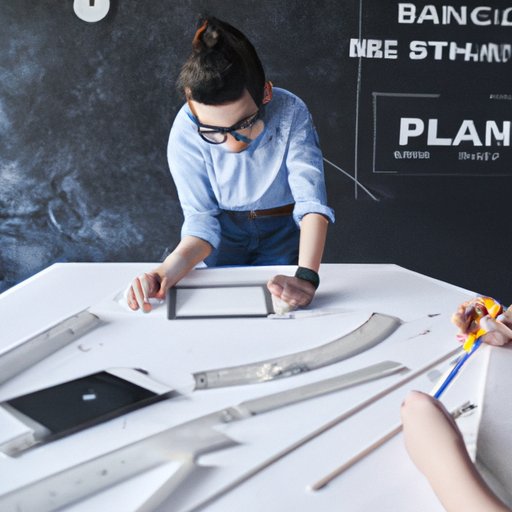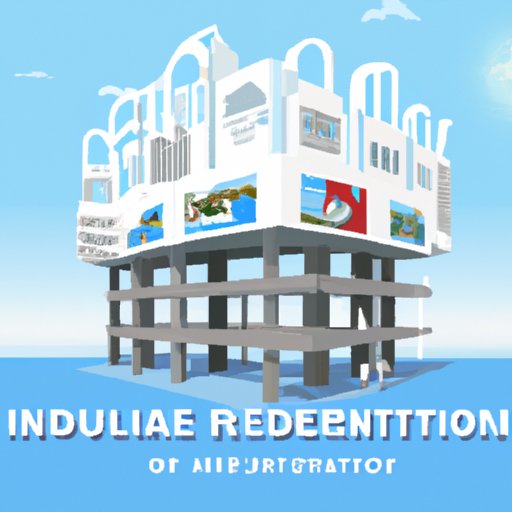Introduction
Architectural technology is a field that combines architecture with engineering and construction management. It involves the use of cutting-edge technology to design and construct buildings and other structures. The goal is to create structures that are both aesthetically pleasing and safe, while also meeting the needs of their occupants. In this article, we’ll explore what architectural technology is, its impact on building design, and how to leverage it for sustainable building design.

Exploring the Basics of Architectural Technology
Before delving into the specifics of architectural technology, it’s important to understand the basics. Architectural technology is the application of scientific principles and technological advances to the design, planning, and construction of buildings and other structures.
The field encompasses a wide range of topics, including building materials, structural design, urban planning, site analysis, and computer-aided design (CAD). Architects use various software programs to create detailed designs and plans, which are then used by engineers and contractors to bring the project to fruition.
Architectural technology also includes the use of advanced tools such as 3D printers, laser scanners, virtual reality (VR) headsets, and robotics. These technologies allow architects to create highly detailed designs, analyze complex structures, and simulate the effects of natural forces and environmental conditions on a building.

An Overview of Emerging Trends in Architectural Technology
As the demand for faster, more efficient, and more sustainable buildings rises, new trends in architectural technology are emerging. Here are some of the most prominent ones:
Virtual Reality/Augmented Reality
Virtual reality (VR) and augmented reality (AR) are becoming increasingly popular in the field of architecture. VR enables architects to immerse themselves in realistic 3D models of their projects, allowing them to make informed decisions quickly and accurately. AR, on the other hand, overlays digital elements onto real-world environments, allowing architects to visualize the results of their work in situ.
3D Visualization and Modeling
3D visualization and modeling tools have revolutionized the way architects design buildings. Architects can now create highly detailed 3D models of their projects, which can be viewed from any angle or perspective. This allows them to identify potential problems before they begin construction, saving time and money.
Automation and Robotics
Robots and automated processes are becoming increasingly common in the construction industry. Automated systems can be used to improve efficiency and accuracy, as well as reduce the risk of human error. Robots can also be used to perform dangerous tasks, such as welding or operating heavy machinery, keeping workers safe.
Understanding Architectural Technology and its Impact on Building Design
The use of architectural technology has had a profound impact on the design and construction of buildings. Here are some of the most notable benefits:
Improved Efficiency and Speed
The use of advanced software and hardware has allowed architects to design and plan buildings much faster than before. This has drastically reduced the amount of time required to complete projects, resulting in cost savings for clients. According to a study by the National Institute of Standards and Technology (NIST), “the use of modern technology has enabled a reduction in design time of up to 70 percent”.
Enhanced Safety and Security
Advanced technologies such as sensors, cameras, and access control systems can be used to monitor and secure buildings. This helps to protect occupants and valuable assets from theft, vandalism, and other threats. Additionally, advanced design techniques can be used to create buildings that are resistant to natural disasters such as earthquakes and floods.
Increased Sustainability
The use of green building materials, energy-efficient systems, and renewable energy sources can help reduce a building’s environmental footprint. This not only benefits the environment but also reduces operational costs in the long run. According to the U.S. Green Building Council, “buildings that incorporate green building practices can save up to 50 percent in energy costs over the life of the building”.
Examining the Role of Technology in Modern Architecture
Technology is playing an ever-increasing role in modern architecture. Here are some of the ways it is being used to improve the design and construction process:
Advances in Design
Software such as CAD and BIM (Building Information Modeling) has made it easier for architects to create detailed designs and plans. This has improved the accuracy and precision of designs, resulting in better buildings.
Streamlined Construction Processes
Advanced technologies such as robotic arms and 3D printing have enabled architects to streamline the construction process. This has resulted in shorter timelines and lower costs.
Smart Building Technologies
The use of smart building technologies such as sensors and automated systems has enabled architects to create buildings that are more efficient and comfortable. These systems can be used to regulate temperature, detect intruders, and monitor energy usage.

How to Leverage Architectural Technology for Sustainable Building Design
In order to create truly sustainable buildings, architects must leverage the latest technologies. Here are some of the best ways to do this:
Incorporating Renewable Energy Sources
Renewable energy sources such as solar panels, wind turbines, and geothermal systems can be used to power a building. Architects can use software to analyze the local climate and determine the best option for each location.
Implementing Smart Solutions
Smart building technologies such as sensors, automated systems, and IoT devices can be used to reduce energy consumption and improve the comfort of occupants. Additionally, these systems can be used to monitor and track energy usage, allowing architects to identify areas that need improvement.
Utilizing Advanced Materials
Modern materials such as nanomaterials, composites, and recycled plastics can be used to create more efficient and sustainable buildings. These materials can also be used to reduce a building’s environmental footprint.
A Guide to the Latest Architectural Technology Solutions
There is a wide range of architectural technology solutions available today. Here is a brief overview of some of the most popular ones:
Software Solutions
Software such as CAD, BIM, and 3D modeling programs can be used to design and plan buildings. These programs enable architects to create detailed designs and plans, analyze complex structures, and simulate the effects of environmental conditions on a building.
Hardware Solutions
Hardware such as 3D printers, laser scanners, and robots can be used to streamline the construction process. These tools can be used to create detailed models, measure and inspect buildings, and automate dangerous tasks.
System Integration
System integration is the process of connecting different systems and components within a building. This includes connecting HVAC systems, lighting systems, security systems, and other systems. System integration makes it easier to monitor and control all of the systems within a building.
Conclusion
Architectural technology has revolutionized the way architects design and construct buildings. It has enabled architects to create highly detailed designs, analyze complex structures, and simulate the effects of environmental conditions on a building. Additionally, it has improved efficiency, safety, and sustainability, resulting in better buildings.
By leveraging the latest technologies, architects can create truly sustainable buildings that are both efficient and comfortable. This includes incorporating renewable energy sources, implementing smart solutions, and utilizing advanced materials. By doing so, they can ensure that their buildings will remain safe and habitable for years to come.
The use of architectural technology is essential for creating buildings that are both aesthetically pleasing and functional. By understanding the basics of architectural technology and leveraging the latest solutions, architects can create buildings that meet the needs of their occupants for years to come.
(Note: Is this article not meeting your expectations? Do you have knowledge or insights to share? Unlock new opportunities and expand your reach by joining our authors team. Click Registration to join us and share your expertise with our readers.)
